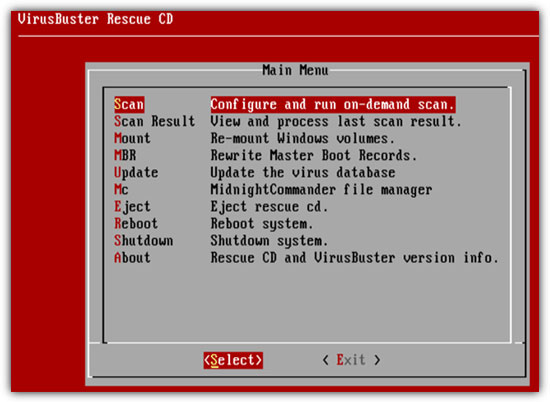
:max_bytes(150000):strip_icc()/microsoft-windows-malicious-software-removal-tool-23ac204903fc43f1927d35abcf50d72c.png)
- #Does avg scan master boot record code
- #Does avg scan master boot record Pc
- #Does avg scan master boot record windows
The MBR consists of 512 or more bytes located in the first sector of the drive. The present non-standard nature of these solutions causes various compatibility problems in certain scenarios. Meanwhile, multiple forms of hybrid MBRs have been designed and implemented by third parties in order to maintain partitions located in the first physical 2 TiB of a disk in both partitioning schemes "in parallel" and/or to allow older operating systems to boot off GPT partitions as well. Specifically, it does not provide backward compatibility with operating systems that do not support the GPT scheme as well. The official approach does little more than ensuring data integrity by employing a protective MBR. The MBR partitioning scheme is therefore in the process of being superseded by the GUID Partition Table (GPT). Consequently, a different partitioning scheme must be used for larger disks, as they have become widely available since 2010. Therefore, the maximum disk size supported on disks using 512-byte sectors (whether real or emulated) by the MBR partitioning scheme (without 33-bit arithmetic) is limited to 2 TiB.
#Does avg scan master boot record code
MBR partition entries and the MBR boot code used in commercial operating systems, however, are limited to 32 bits.

Sometimes this was in addition to other pre-existing or cross-platform standards for bootstrapping and partitioning. This was even to the extent of being supported by computer operating systems for other platforms. However, this design rule was partially compromised in more recent Microsoft implementations of the MBR, which enforce CHS access for FAT16B and FAT32 partition types 0x06/ 0x0B, whereas LBA is used for 0x0E/ 0x0C.ĭespite sometimes poor documentation of certain intrinsic details of the MBR format (which occasionally caused compatibility problems), it has been widely adopted as a de facto industry standard, due to the broad popularity of PC-compatible computers and its semi-static nature over decades. This also reflected the idea that the MBR is meant to be operating system and file system independent.
#Does avg scan master boot record windows
In 1996, support for logical block addressing (LBA) was introduced in Windows 95B and DOS 7.10 in order to support disks larger than 8 GB. Since MS-DOS, PC DOS, OS/2 and Windows were never enabled to boot off them, the MBR format and boot code remained almost unchanged in functionality, except for in some third-party implementations, throughout the eras of DOS and OS/2 up to 1996. Support for an extended partition, a special primary partition type used as a container to hold other partitions, was added with DOS 3.2, and nested logical drives inside an extended partition came with DOS 3.30. This did not change when FAT16 was introduced as a new file system with DOS 3.0. The partition table supported up to four primary partitions, of which DOS could only use one. The original version of the MBR was written by David Litton of IBM in June 1982.

Support for partitioned media, and thereby the master boot record (MBR), was introduced with IBM PC DOS 2.0 in March 1983 in order to support the 10 MB hard disk of the then-new IBM Personal Computer XT, still using the FAT12 file system. MBRs are not present on non-partitioned media such as floppies, superfloppies or other storage devices configured to behave as such. A GPT can coexist with an MBR in order to provide some limited form of backward compatibility for older systems. Therefore, the MBR-based partitioning scheme is in the process of being superseded by the GUID Partition Table (GPT) scheme in new computers. Approaches to slightly raise this limit assuming 32-bit arithmetics or 4096-byte sectors are not officially supported, as they fatally break compatibility with existing boot loaders and most MBR-compliant operating systems and system tools, and can cause serious data corruption when used outside of narrowly controlled system environments. The organization of the partition table in the MBR limits the maximum addressable storage space of a partitioned disk to 2 TiB (2 32 × 512 bytes). This MBR code is usually referred to as a boot loader. The MBR also contains executable code to function as a loader for the installed operating system-usually by passing control over to the loader's second stage, or in conjunction with each partition's volume boot record (VBR). The MBR holds the information on how the logical partitions, containing file systems, are organized on that medium.
#Does avg scan master boot record Pc
The concept of MBRs was publicly introduced in 1983 with PC DOS 2.0. For the first sector on non-partitioned media, see volume boot record.Ī master boot record ( MBR) is a special type of boot sector at the very beginning of partitioned computer mass storage devices like fixed disks or removable drives intended for use with IBM PC-compatible systems and beyond. This article is about a PC-specific type of boot sector on partitioned media.


 0 kommentar(er)
0 kommentar(er)
